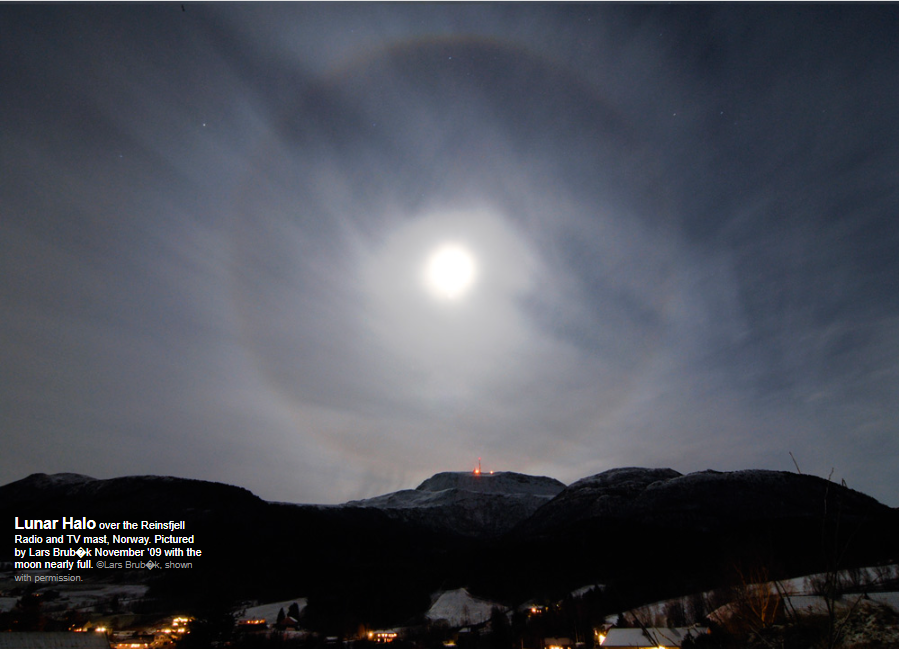Moon Halo
Moon Halo: A Phenomenon of Light and Beauty
Have you ever looked up at the night sky and been captivated by a ring of light surrounding the moon? This enchanting sight is known as a moon halo, and it is a fascinating atmospheric optics phenomenon that has intrigued observers for centuries. In this article, we will delve into the science behind moon halos, explore their causes, and uncover the secrets of their ethereal beauty.
What is a Moon Halo?
A moon halo is a luminous ring that encircles the moon, creating a captivating display of light in the night sky. It is formed when moonlight interacts with ice crystals suspended in the Earth's atmosphere. These ice crystals act as tiny prisms, refracting and reflecting the moonlight to create the halo effect. Moon halos typically have a diameter of about 22 degrees, although they can occasionally appear larger or smaller depending on atmospheric conditions.
The Science Behind Moon Halos
Moon halos are an example of a phenomenon called a "circumhorizontal arc." This optical effect occurs when sunlight or moonlight passes through hexagonal ice crystals in the atmosphere. The light is refracted as it enters the crystal, then reflects off the crystal's interior surfaces before exiting and creating the halo. The angle at which the light is bent determines the size and shape of the halo.
Types of Moon Halos
Moon halos can come in different forms, each with its own unique characteristics. Some common types of moon halos include:
- 22-Degree Halo: This is the most frequently observed type of moon halo. It appears as a circular ring with a radius of approximately 22 degrees around the moon.
- Circumzenithal Arc: This type of halo forms a bright spot or arc located directly above the observer's head. It often appears as an upside-down rainbow.
- Supralateral Arc: The supralateral arc is a rare and captivating halo that forms a horizontal arc passing through the moon. It is often seen in conjunction with a 22-degree halo.
Causes of Moon Halos
Moon halos are created by the interaction of moonlight with ice crystals in the atmosphere. These ice crystals can be found at various altitudes, ranging from high cirrus clouds to lower-level altocumulus clouds. The ice crystals act as prisms, bending and reflecting the moonlight to create the halo effect.
Factors Affecting Moon Halo Visibility
Several factors can influence the visibility and appearance of moon halos. These include:
- Weather Conditions: Moon halos are more likely to occur in cold, clear skies with high-altitude clouds. Cloud cover or precipitation can obstruct the view of the halo.
- Moon Phase: Moon halos are most prominent when the moon is nearly full, as this is when its light is brightest.
- Altitude of Ice Crystals: The altitude at which ice crystals are present in the atmosphere can impact the visibility and size of the moon halo.
Capturing the Beauty of Moon Halos
Moon halos provide a captivating subject for photography enthusiasts. To capture the beauty of a moon halo, consider the following tips:
- Use a tripod to keep your camera steady and avoid blurring.
- Experiment with different exposure settings to achieve the desired effect.
- Include interesting foreground elements to add depth and context to your photographs.
Folklore and Cultural Significance
Throughout history, moon halos have been regarded as omens or symbols in various cultures around the world. In folklore, they have been associated with celestial events, changes in weather, or even spiritual significance. Different cultures have their own interpretations and beliefs surrounding moon halos, adding to their mystical allure.
Embrace the Magic of Moon Halos
Next time you find yourself gazing at the night sky and notice a luminous ring encircling the moon, take a moment to appreciate the beauty and wonder of a moon halo. These captivating atmospheric optics phenomena remind us of the intricacies of our planet's atmosphere and the hidden wonders that can be found just by looking up. So, go ahead, embrace the magic of moon halos and let yourself be transported into a world of ethereal beauty and celestial enchantment.

Lunar Halo over the Reinsfjell Radio and TV mast, Norway. Pictured by Lars Brub�k November '09 with the moon nearly full. ©Lars Brub�k, shown with permission.
Note: this article has been automatically converted from the old site and may not appear as intended. You can find the original article here.
Reference Atmospheric Optics
If you use any of the definitions, information, or data presented on Atmospheric Optics, please copy the link or reference below to properly credit us as the reference source. Thank you!
-
<a href="https://atoptics.co.uk/blog/moon-halo/">Moon Halo</a>
-
"Moon Halo". Atmospheric Optics. Accessed on November 26, 2024. https://atoptics.co.uk/blog/moon-halo/.
-
"Moon Halo". Atmospheric Optics, https://atoptics.co.uk/blog/moon-halo/. Accessed 26 November, 2024
-
Moon Halo. Atmospheric Optics. Retrieved from https://atoptics.co.uk/blog/moon-halo/.